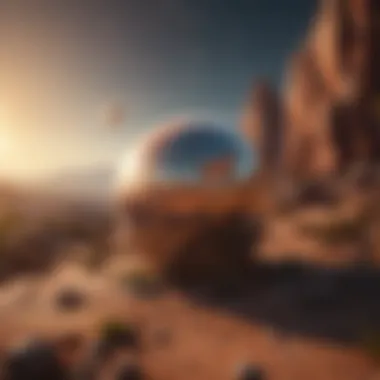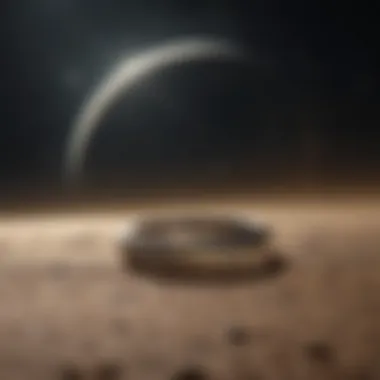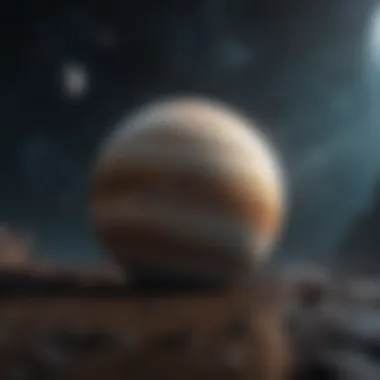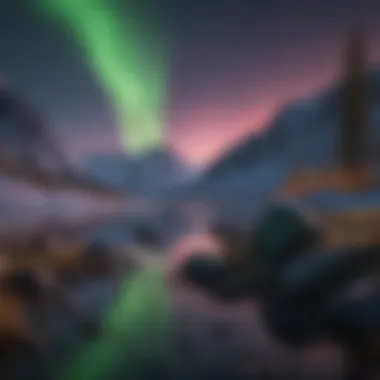Unveiling the Enigmatic Planetary Systems Across the Cosmos


Nature Topic Overview
As we embark on a voyage through the boundless expanse of planetary systems, we are faced with a universe brimming with enigmatic wonders waiting to be discovered. From the scorching landscapes of Mercury to the frozen realms of Neptune, each celestial body offers a unique tapestry of geological formations and atmospheric compositions that intrigue and inspire us with their incomprehensible grandeur.
Stay tuned as we delve deeper into the mysteries of these planets, unraveling their hidden secrets and shedding light on the captivating worlds that orbit distant stars. Prepare to be awed by the sheer magnitude of cosmic phenomena awaiting us beyond the confines of our solar system.
Introduction to Planets
What are Planets?
Planets, enigmatic entities suspended in the vastness of space, are pivotal players in the cosmos. Defined by their spherical shape and orbit around a star, these celestial bodies come in various sizes and compositions. From the rocky surfaces of Mercury to the gaseous atmospheres of Jupiter, each planet boasts unique characteristics that set them apart from one another. Understanding the fundamental nature of planets is crucial in unraveling the mysteries of our solar system and beyond.
Formation of Planets
The formation of planets is a complex ballet of cosmic forces and interactions that spans millions of years. Emerging from protoplanetary disks encircling young stars, planets gradually coalesce from dust and gas, undergoing tumultuous processes of accretion and consolidation. This transformative journey gives rise to the diverse array of planets we observe today, each bearing a testament to the turbulent origins of our celestial neighborhood.
Classification of Planets
In the vast expanse of the cosmos, planets are classified into distinct categories based on various criteria such as composition, location, and characteristics. From the inner terrestrial planets like Mercury and Mars to the giant gas planets of Jupiter and Saturn, each class represents a unique archetype in planetary formation. By unraveling the classification of planets, astronomers can gain valuable insights into the underlying principles governing the evolution and distribution of planetary systems.
Inner Terrestrial Planets
In the vast expanse of our solar system, the Inner Terrestrial Planets hold a special place. Mercury, Venus, Earth, and Mars, the four rocky planets closest to the sun, offer a unique glimpse into the formation and evolution of planetary bodies. They symbolize resilience, with their solid surfaces resisting the harsh realities of space. Studying the Inner Terrestrial Planets not only unveils the history of our solar system but also provides valuable insights into the potential for life beyond Earth. Through detailed exploration and analysis, we can unearth the secrets these terrestrial worlds hold, shedding light on the possibilities of existence in the cosmic neighborhood.
Mercury


Mercury, the closest planet to the sun, dances to its own tunes in a realm of extremes. With scorching daytime temperatures and freezing nights, this small planet maintains a delicate balance between chaos and order. Its barren, cratered surface narrates a saga of resilience, where the planet stands stoic against the solar onslaught. Despite its proximity to the sun, Mercury harbors ice in its shadowed craters, defying conventional expectations. Delving into the mysteries of Mercury unravels the complexities of planetary dynamics, offering a fresh perspective on the limits of habitability and the endurance of life forms in the most unlikely of havens.
Venus
The enigmatic Venus, shrouded in thick clouds of sulfuric acid, presents a paradoxical allure. Its runaway greenhouse effect generates surface temperatures capable of melting lead, portraying a cautionary tale of unchecked climatic processes. Beneath its veiled facade lies a geologically active world, with massive volcanic structures hinting at a tumultuous past. Venus challenges our perceptions of planetary habitability, prompting questions about the delicate balance necessary to sustain life. Exploring Venus unveils not only the perils of unchecked environmental change but also the resilience of life forms in adapting to extreme conditions.
Earth
Earth, the cradle of humanity, stands out as a beacon of life in the vastness of space. Its intricate ecosystems and diverse landscapes teem with vitality, showcasing the resilience and adaptability of life forms. From the icy realms of Antarctica to the scorching heat of deserts, Earth's varied environments offer a tapestry of survival strategies. Studying Earth provides valuable insights into the interconnectedness of life and the delicate balance required to maintain thriving ecosystems. By delving into the wonders of our home planet, we gain a deeper appreciation for the intricacies of life and the challenges posed by environmental changes.
Mars
Mars, the dusty red planet, captivates with its stark beauty and mystique. Its ancient riverbeds and towering volcanoes paint a picture of a dynamic world, hinting at a history enriched with geological upheavals. Mars's thin atmosphere and frozen polar caps spark curiosity about the potential for past or present life on the planet. Exploring Mars opens a window into the possibilities of terraforming and human colonization beyond Earth, paving the way for future interplanetary endeavors. By studying Mars, we unravel the complexities of planetary evolution and the interplay of geological processes, offering a glimpse into the mysteries of our neighboring world.
Giant Gas Planets
Giant Gas Planets stand out as colossal entities in the realm of planetary systems, characterized by their vast gaseous composition and immense size compared to their terrestrial counterparts. These massive planets, namely Jupiter, Saturn, Uranus, and Neptune, play a pivotal role in shaping the dynamics of our solar system and beyond. Their sheer magnitude and intricate atmospheres offer a treasure trove of scientific intrigue for astronomers and researchers alike.
Within the context of this article, delving into the vast expanse of Giant Gas Planets illuminates the diversity and uniqueness of these celestial bodies. From the mesmerizing rings of Saturn to the turbulent storms of Jupiter, each planet presents a tapestry of distinct features that broaden our understanding of planetary formations and dynamics. Exploring Giant Gas Planets unveils a cosmic symphony of beauty and complexity that captivates the imagination and fuels astronomical curiosity.
Jupiter
Jupiter, the largest planet in our solar system, commands attention with its majestic presence and awe-inspiring characteristics. This gas giant, enveloped in swirling bands of clouds and a colossal red spot, showcases the immense power and scale of planetary forces at play. Jupiter's magnetic field, strong enough to influence its moons and generate impressive auroras, underscores the planet's dynamic nature and astronomical significance.
Saturn
Saturn, renowned for its stunning ring system, stands out as a prominent figure among the Giant Gas Planets. The intricate patterns and delicate beauty of Saturn's rings epitomize the grace and elegance found in celestial bodies. Beneath this captivating exterior lies a world of diverse moons, including Titan with its dense atmosphere and potential for scientific exploration, adding depth to Saturn's mystique and scientific importance.


Uranus
Uranus, a unique ice giant with a peculiar axial tilt, offers a glimpse into the unconventional nature of planetary dynamics. This sideways planet, cloaked in an icy shroud of methane and hydrogen, challenges traditional notions of planetary orientation and revolution. The distinct features of Uranus invite further scrutiny and exploration to unravel the mysteries hidden within its icy veil.
Neptune
Neptune, the farthest Giant Gas Planet in our solar system, intrigues with its vibrant blue hues and tumultuous weather patterns. This distant world, marked by powerful winds and mysterious dark spots, exemplifies the dynamic nature of planetary atmospheres and weather systems. Neptune's enigmatic features beckon scientists to delve deeper into its atmospheric mysteries and unearth new insights into the complexities of gas giants.
Dwarf Planets
Dwarf planets hold a crucial place in the vast expanse of celestial bodies explored in this comprehensive article. Despite their smaller size compared to full-fledged planets, they offer a unique perspective on the diversity of planetary systems. Dwarf planets challenge traditional definitions and expand our understanding of the cosmos with their intriguing characteristics. By shedding light on these enigmatic bodies, we gain valuable insights into the complexities of our solar neighborhood and beyond.
Pluto
Pluto, once hailed as the ninth planet of our solar system, underwent a reclassification to the status of a dwarf planet in 2006. Despite its diminutive size, Pluto continues to fascinate astronomers and enthusiasts alike. Its distant orbit beyond Neptune's realm presents a puzzling enigma that ignites curiosity about the outer reaches of our cosmic backyard. Exploring the icy plains of Pluto unveils a world of mysteries and possibilities, showcasing the resilience and adaptability of celestial bodies in the cold expanse of space.
Eris
Eris, a dwarf planet on the outskirts of our solar system, challenges our perceptions of planetary classifications. Its discovery in 2005 prompted a reevaluation of what defines a planet, leading to discussions on the dynamics of our celestial neighborhood. Eris's remote position and icy composition offer a glimpse into the outer limits of our understanding, reminding us of the vastness of the cosmos and the constant evolution of astronomical knowledge.
Haumea
Haumea, with its elongated shape and rapid rotation, stands out as a peculiar dwarf planet in our cosmic tapestry. Named after the Hawaiian goddess of fertility, Haumea embodies the creative forces at play in our celestial realm. Its unique features spark discussions on the formation and evolution of planetary bodies, highlighting the diverse paths taken by objects in our solar system. Delving into the intricacies of Haumea unveils a world of wonder and complexity, underscoring the mesmerizing nature of dwarf planets.
Makemake
Makemake, with its distant orbit and frigid surface, exemplifies the resilience of dwarf planets in the outer reaches of our solar system. Discovered in 2005, Makemake added to the growing family of dwarf planets, expanding our planetary knowledge. Its orbit beyond Neptune hints at the remnants of our solar system's formation, prompting reflections on the history and dynamics of celestial bodies. Exploring the icy plains of Makemake unveils a realm of icy beauty and scientific wonder, beckoning us to contemplate the mysteries of the universe.


Moons and Rings
In the vast expanse of the cosmos, the topic of Moons and Rings plays a pivotal role in our understanding of planetary systems. Moons, such as Io and Titan, along with the rings of planets like Saturn, offer a wealth of insights into the dynamics and intricacies of celestial bodies. These elements serve as celestial companions, influencing phenomena like tides, planetary rotations, and even potential habitability. Through exploring Moons and Rings, we can unravel layers of complexity that enrich our exploration of the wonders of planetary systems.
Io (Jupiter's Moon)
Io, the volcanic moon of Jupiter, stands out as a captivating world of extreme geological activity. Its surface is dotted with the aftermath of volcanic eruptions, showcasing a landscape unlike any other in our solar system. The constant interplay between Jupiter's immense gravitational forces and Io's internal heat generates a spectacle of volcanism unparalleled in our celestial neighborhood. Studying Io provides us with valuable insights into the geophysical processes that shape planetary bodies, offering a glimpse into the raw power of nature.
Titan (Saturn's Moon)
As the largest moon of Saturn, Titan presents a world veiled in a thick atmosphere rich in nitrogen and hydrocarbons, resembling primordial Earth in some aspects. Its methane lakes and ethereal haze intrigue scientists, hinting at potential similarities to early Earth conditions. By delving into Titan's mysteries, we can draw parallels between its environment and early Earth, expanding our understanding of planetary evolution and the diverse forms life could take in the cosmos.
Rings of Saturn
Saturn's iconic rings symbolize a celestial marvel that has fascinated astronomers for centuries. Composed of icy particles ranging from minuscule grains to grand icy chunks, these rings create a mesmerizing display of cosmic elegance. By studying Saturn's rings, scientists gain insights into the dynamics of orbital mechanics, planetary formation, and the delicate balance of gravitational forces at play in our solar system. The rings serve as a testament to the intricate dance of celestial bodies, offering a window into the mechanisms that shape our cosmic neighborhood.
Triton (Neptune's Moon)
Triton, Neptune's largest moon, stands out as a world of icy plains and geysers, shrouded in an atmosphere of nitrogen and methane. Its retrograde orbit around Neptune and unique geological features challenge existing theories of moon formation, sparking intrigue and scientific debate. Exploring Triton provides us with a glimpse into the interplay between planetary bodies and their moons, shedding light on the fascinating diversity of worlds within our solar system. Through investigating Triton, we can uncover more about the dynamic interactions that shape celestial bodies and their orbits, opening doors to new frontiers of astronomical understanding.
In the vast expanse of the cosmos, beyond our familiar solar system, lie the intriguing realms of exoplanets and beyond. This section catapults us into the realms of the unknown, shedding light on celestial bodies that orbit distant stars. Here, we confront the enigma of worlds that defy our conventional understanding, expanding our cosmic horizons.
Kepler-186f
Nestled within the Kepler-186 system, Kepler-186f emerges as a crucial subject of astronomical fascination. This exoplanet, located approximately 582 light-years away, offers a glimpse into the potential for habitable worlds beyond our solar system. Kepler-186f orbits within the habitable zone of its star, raising questions about the possibility of extraterrestrial life. Its rocky composition and distant location beckon us to contemplate the vast diversity of planetary formations across the universe.
Trappist-1e
Among the intriguing array of exoplanets, Trappist-1e stands out as a beacon of exploration. Situated within the habitable zone of the ultra-cool dwarf star Trappist-1, this planet captivates astronomers with its potential for liquid water and temperate conditions. Trappist-1e sparks hypotheses about the presence of atmosphere and the complexities of sustaining life outside our solar confines. Delving into its mysteries unravels the tapestry of possibilities in the realm of exoplanetary research.
Beyond Our Solar System
Venturing further into the cosmic unknown, we encounter a myriad of worlds outside the familiar boundaries of our solar system. The prospect of exploring these distant celestial bodies opens a new chapter in astronomical exploration. As we gaze towards the stars and contemplate the realms beyond, we come face to face with the boundless opportunities for discovery and scientific advancement. Beyond our solar system lies a tapestry of uncharted territories, beckoning humanity to expand its understanding of the universe.







